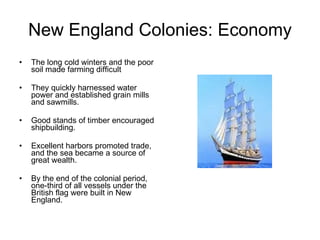The economy of the New England colonies, which included the colonies of Massachusetts, Connecticut, Rhode Island, and New Hampshire, was primarily centered on agriculture and trade. The region's rocky soil and harsh climate were not well suited for large-scale farming, so the colonists relied on small-scale farming and livestock raising to sustain themselves. However, the New England colonies also had a diverse economy that included manufacturing, fishing, and trade.
Agriculture in the New England colonies was focused on producing enough food to sustain the local population. The colonists grew a variety of crops, including wheat, corn, oats, and vegetables. They also raised livestock such as cattle, pigs, and chickens. The harsh climate and rocky soil of the region made farming difficult, so most farmers in the New England colonies had small plots of land.
Manufacturing was another important aspect of the New England colonies' economy. The region had abundant natural resources, such as timber, which was used to produce a variety of goods, including furniture, ships, and buildings. The New England colonies also had access to water power, which was used to operate gristmills and sawmills. In addition, the region had skilled craftsmen who produced goods such as textiles, pottery, and iron goods.
Fishing was also an important part of the New England colonies' economy. The region had a long coastline and an abundance of fish, including cod, haddock, and halibut. The fishermen in the New England colonies used both traditional methods, such as using nets and lines, and more modern methods, such as using seine nets and steam-powered boats. Fish was an important source of food for the colonists, and it was also a major export.
Trade was another key component of the New England colonies' economy. The region had a thriving trade network that included both local and international trade. The colonists traded with other colonies in North America, as well as with Europe and the West Indies. The New England colonies exported a variety of goods, including fish, timber, and manufactured goods. They also imported goods from other regions, including spices, sugar, and molasses.
Overall, the economy of the New England colonies was diverse and centered on agriculture, manufacturing, fishing, and trade. Despite the challenges posed by the region's harsh climate and rocky soil, the colonists were able to sustain themselves and build a thriving economy.






